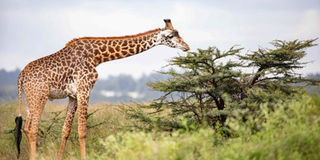Giraffes set to be tracked using solar-powered GPS

Giraffes in Kidepo Valley National Park. Over the years, giraffes have been thought to have only a specie. PHOTO/XINHUA
What you need to know:
- According to GCF, there are only about 117,000 giraffes remaining in Africa and there is still a lot to learn about their movements and how they use their habitat.
In June, the Zimbabwe Parks and Wildlife Management Authority (ZimParks) in collaboration with the Namibian-based NGO Giraffe Conservation Foundation (GCF) embarked on an innovative operation of fitting solar-powered GPS satellite tags on 14 Southern giraffes in Hwange National Park, Zimbabwe.
Conservation managers and researchers can now follow the movements of these giraffes online from anywhere in the world as they move within the Kavango-Zambezi Transfrontier Conservation Area (KAZA TFCA) landscape. This tagging exercise was the first of its kind in Hwange National Park and created the perfect platform for building local capacity in Zimbabwe by training park rangers and conservation officials in best practice giraffe capture techniques.
As part of their Africa-wide Twiga Tracker Initiative, GCF follows and analyses the movements of all four giraffe species in 10 African countries. Data from this groundbreaking study will contribute to this important initiative and ultimately inform giraffe conservation actions locally and throughout the continent.
“We are excited to follow these giraffes online and find out more about where they go and what they do,” says Daphine Madhlamoto, acting principal ecologist at ZimParks.
Data from these innovative GPS units will help improve the conservationists’ understanding of giraffe movements and habitat requirements throughout this landscape.
GCF recently facilitated the development of the first-ever KAZA-wide Giraffe Conservation Strategy during a collaborative workshop with representatives of all five partner states and local conservation partners. It is awaiting final approval and will soon guide giraffe conservation efforts in this critical landscape which collectively supports 10 percent of Africa’s wild giraffe population.
For Zimbabwe, the data is anticipated to help build a baseline for a proposed development of a National Giraffe Conservation Strategy and Action Plan for the country. Over the past three years, GCF in collaboration with ZimParks and local conservation partners have already collated a detailed estimate of giraffe numbers, established their range and started to assess their taxonomic status.
“Conservation cannot happen in isolation. Only when all partners come together can we reach the best outcomes for giraffe conservation in Zimbabwe,” says Dr Julian Fennessy, director of conservation at GCF.
According to GCF, there are only about 117,000 giraffes remaining in Africa and there is still a lot to learn about their movements and how they use their habitat.




